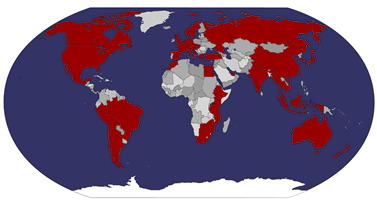
The Mayflower in Rotherhithe Street is one of those historic pubs in London that you have to visit at some point. Despite being in the capital for over 12 years, that time came only this weekend and by chance!
What's the story then? From the quayside here, near a pub called the Shippe, the Mayflower set sail for America in the spring of 1620, carrying Protestants fleeing religious persecution. Captain Christopher Jones and his passengers were to become the Pilgrim "Founding" Fathers.
The Mayflower and its crew returned to Rotherhithe in 1621. Jones died a year later and was buried at St. Mary’s Churchyard opposite. A century later the Shippe was rebuilt and renamed the Spread Eagle and Crown. In 1957 the pub was restored and renamed the Mayflower.
It is apparently licensed to sell both U.S. and British postage stamps, having been a post office for the river, though it is not clearly whether this right has survived the latest Government post office closure rounds, or indeed whether Mandelson plans to sell part of the pub to TNT.
With a mere two pounds in my pocket, it was a half of Abbot for me, the beer being of the Greene King variations. I explored the pub - it is very cosy, with pictures and drawings of the area and its nautical connections.

The food has won awards, but was not to be sampled today. Out the other side, the riverside terrace is pleasant, with one especially interesting feature - the doors leading out to it from the pub appear to be flood doors, and given the green algae right up them, I presume they are used on a regular spring-tide basis!

If you fancy visiting, a milestone on the front of the pub notes that it is two miles to London Bridge along the Thames Path. Alternatively, Canada Water on the Jubilee is the closest station.
The Brunel Tunnel and Museum

So how did I happen upon the Mayflower? Simple - it's opposite the Brunel Museum, which I visited on Saturday. It had to be Saturday as this was the last day of the special access to the Brunel Tunnel, happening every Saturday in December, and possible because of engineering work on the East London Lines meaning the tunnel was not in use by tube trains.

The rail entrance to the tunnels today
AN UNDERGROUND CATHEDRAL!
Half the diameter of the dome of St Paul’s, the grand entrance hall of the Thames Tunnel had been opened up for the first time in a hundred and forty years. In 1825 Brunel allowed visitors to see the works for a shilling; this became a "suggested" donation of £5. Views were subject to the constraints imposed by the building programme.

The work is part of extending the Brunel Museum into the lift shaft.

How the hall will look
So what's the story with the tunnel? Built by Sir Marc Brunel and his son Isambard between 1825 and 1843, the tunnel connected Wapping with Rotherhithe, and was revolutionary in being the first tunnel anywhere through soft ground under water, and is still the oldest tunnel on the present London Underground.
On its first day of opening 50,000 people walked through the tunnel, which was hailed as one of the new wonders of the world, and a million visits were chalked up in the first 15 weeks (NB London at this time only had a total population of about double this!)
Unfortunately without the access tunnels which were planned, freight never used the tunnel, and after 20 years as an underwater shopping arcade and a venue for tightrope walkers and sword swallowers, it was finally sold in 1869 and became a railway tunnel.
The skill of the workforce and the genius of the Brunels had achieved their aim at last - the tunnel carried cargo. It was electrified and became part of the Underground in 1913.

A Sketch of the original tunnel
So what were we doing today? I had understood that we were to go down into the tunnels via the access shaft, and after about an hour and a half's wait, spent in the museum and attached cafe (fine carrotcake), it was my turn, along with three others.
We were led round the fence, and had to climb over a wall, duck down and creep into a hole about 3 feet high. Inside here, we were at the top of scaffolding over the shaft. But what's this? No tunnels! They had just installed a concrete floor down below, over the tunnel roof!
We could see the markings on the wall where the original staircase went down, and haf some of our view explained by the chap from the museum shouting through the hole. It was very cramped, and worth seeing, but a real shame we didn't get to see the tunnels - I thought this was the whole point - that with the trains not running we could go down? Oh well..

Interesting, but not exactly what I had expected!
The Thames Barrier

Working so often in East London recently, I thought this was the perfect opportunity to pop along and have a closer look at the Thames Barrier, which I did by bus from Greenwich.
There's a visitor's centre, but I settled for the close up walk along the river approach. Ideally I'd recommend visiting to see one of the scheduled maintenance closures, as listed on the website above. They're generally early morning (gulp!).

So what is it? The Thames Barrier is a flood prevention system on the River Thames, constructed between 1974 and 1984 at Woolwich Reach, and first used defensively in 1983. It has been used over 100 times defensively, and is the world's second largest movable flood barrier.
It is designed to prevent a high-tide storm surge combination from flooding central London. As my family live *downstream* of it, this is of particular interest... where does all this water go?! Still, my family's house is at least a few metres above sea level, we'll be alright until the polar caps melt! But how will the Tate and Lyle sugar factory across the river survive?!

Tate and Lyle
Before 1990, the number of barrier closures was one to two per year on average. Since 1990, the number of barrier closures has increased to an average of about four per year. In 2003 the Barrier was closed on 14 consecutive tides. The barrier was closed twice on 9 November 2007 after a storm surge in the North Sea which was compared to the one in 1953.
Right. It's freezing. Time to go home!












































